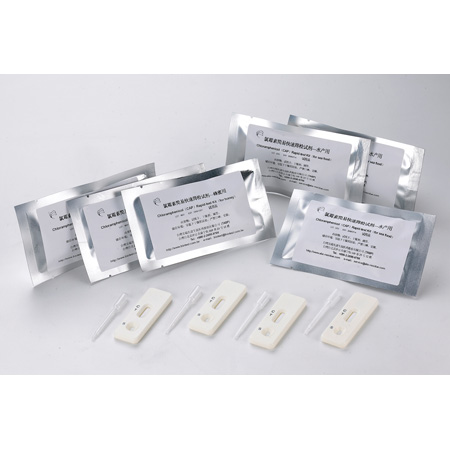Enzyme Immunoassay Kit
| Item No.: | 102066B |
Supplier Details
Country: Taiwan
City: New Taipei City 221
Address: 12F, -3, No.25, Lane 169, Kangning St., Xizhi Dist.
TEL: +886-2-26926222
Fax: +886-2-26959819

Online Showroom:
62 Products
Chloramphenicol (CAP) Rapid Test Kit (Tissue)
The Chloramphenicol chromatographic diagnostic kit is based on the specific immuno-chemical reactions between antigen and antibody. It relies on the competition between Chloramphenicol residues in the sample and the Chloramphenicol immobilized on T line on the membrane for the Chloramphenicol antibody-dye conjugate. Since the drug has been presenting in the sample, it will compete with the drug immobilized on T line, to the limited amount of dye-antibody. As a sufficient amount of drug in the sample is presenting, the drug will saturate the antibody. Consequently, it will show an extremely light or even invisible T line, indicating a positive result. On the other hand, if there is a negative sample (or the amount of the drug is lower than the minimum detectable concentration, 0.3 ppb), it will generate two obvious lines in both the T and C line section.
- Rapid result – 5 minutes
- Reproducibility is quite well.
- Interpretation – easy.
- As low as 0.3 ppb can be detected in fish, shrimp, squid and other seafood, chicken, pork.
- Low price, high quality, and rapid delivery.
- Taiwan Made.
The Chloramphenicol chromatographic diagnostic kit is based on the specific immuno-chemical reactions between antigen and antibody. It relies on the competition between Chloramphenicol residues in the sample and the Chloramphenicol immobilized on T line on the membrane for the Chloramphenicol antibody-dye conjugate. Since the drug has been presenting in the sample, it will compete with the drug immobilized on T line, to the limited amount of dye-antibody. As a sufficient amount of drug in the sample is presenting, the drug will saturate the antibody. Consequently, it will show an extremely light or even invisible T line, indicating a positive result. On the other hand, if there is a negative sample (or the amount of the drug is lower than the minimum detectable concentration, 0.3 ppb), it will generate two obvious lines in both the T and C line section.
 English
English
 中文繁體
中文繁體 Русско
Русско Deutsch
Deutsch Español
Español Português
Português Français
Français Türk
Türk Italiano
Italiano Nederlands
Nederlands हिन्दी
हिन्दी Bahasa Indonesia
Bahasa Indonesia
